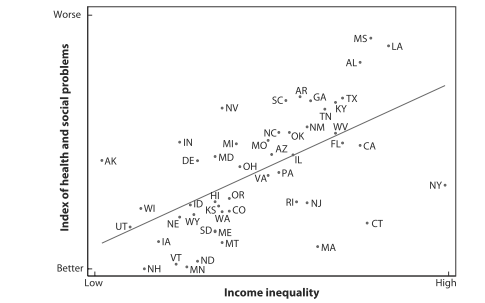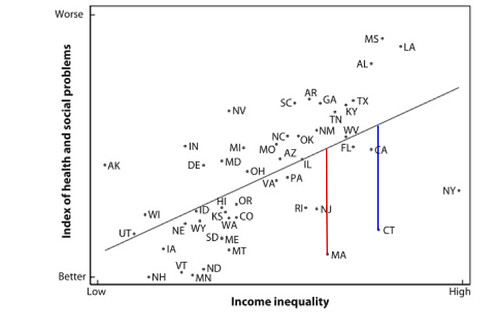After finding this post about income inequality and social problems, I decided to check out the 'book version', The Spirit Level: Why More Equal Societies Almost Always do Better, by epidemiologists Richard Wilkinson and Kate Pickett. It has a lot to recommend it (if you want the short pdf version, it's available here). First, the evidence for a correlation across countries and within countries between income inequality and social misery is pretty overwhelming. Second, in the introduction, as opposed to an appendix nobody will read, Wilkinson and Pickett explain the basics of the statistical methods they use in language that non-mathematically inclined people can understand.
The authors construct an "index of health and social problems" which equally weights (in the U.S. cases) the following*: trust, mental illness, life expectancy, infant mortality, obesity, educational performance, teenage births, homicides, and imprisonment rates. They then asked if this index is correlated with the Gini coefficient, which measures income inequality**. Here's what they found:

I realize that the authors are trying to convince people that income inequality is a bad thing--and it is, for every economic group. The authors do that rather well. But what I found interesting isn't just the relationship (higher income inequality means more social dysfunction), although sadly, we still have to 'debate' this. What's interesting is the residual: the variation around the regression line not explained by the relationship. In the above figure, the residual of each point is the distance a point is from the line if you were to draw a line parallel to the y-axis from the regression line that ran to the data point (a bit of an oversimplification, but it will do; red and blue lines are for MA and CT):

Some states do much better than expected (e.g., MA, NJ, CT, ND, MN, NY) than would be predicted by their income inequality, while others do much worse (e.g., AL, MS, LA, AK, AR). Why these below or above par performances exist is rarely touched on, except in one case: homicides. In terms of homicide rates, Massachusetts, New York, and Rhode Island all much better than would be predicted; while there is a significant correlation, it is rather weak (i.e., large residuals in both directions). However, when the homicide rate is adjusted by gun ownership rates, the correlation becomes very tight. In other words, NY, MA, and a few other states overcome income inequality through lower gun ownership rates; likewise, the various 'murder alleys' don't do so bad once you realize you can't walk ten feet without tripping over a firearm (this does make sense, since two-thirds of U.S. homicides are committed with firearms).
On a subject less depressing than murder and poor health, I've made the same point about educational test scores: some states seem to do much better than their childhood poverty rates would suggest. Whatever those states are doing, other states should learn from those cases and implement those policies (and we definitely should not overturn policies in states that are educating children well).
I wish Wilkinson and Pickett had spent more time discussing the residuals (even if it were only to propose testable hypotheses), since that's one way we can dramatically improve public policy, and thereby, quality of life.
*The various values are normalized for each metric, and the z-score is used; the separate scores are then summed (I think).
**The authors demonstrate that other measures of inequality, such as the ratio of incomes of the top tenth and the bottom tenth yield similar results. What I would find interesting is what would happen if the percentage of people living in poverty (adjusted for each state's cost of living) were used.

History would suggest that as countries get richer, inequality shrinks. Much of history involves farmers who are sometimes on the edge of starvation, and a few rich Lords and Churchmen. It's not too surprising that a bit of economic growth shrinks the disparities. It would be hard to widen them since people on the edge of starvation leave the stats if they get any poorer.
dearieme: I think it could be more easily said that income disparity shrinks (at least most significantly) with major shifts in a country's economic paradigm. China makes a great example: Their ongoing transition from an industrial/agricultural-based economy to a tech-based one creates the need for a large educated middle class, the emergence of which will obviously reduce income inequality.
On the other hand, while the US has seen major economic growth in the last 40 years, the income disparity between the richest and the poorest Americans has grown significantly. Wages are struggling to keep up with the cost of inflation, and at the poorest levels (especially the minimum wage) are completely failing to do so.
Things like these make me wonder what our country would look like today if our current student financial aid programs, and our current attitudes toward college admission and attendance (especially the trend of older professionals going back to school), were in place 40 years prior. Would we still be dealing with the stagnating service-based economy we have today? Would we have an abundance of college-educated professionals and people skilled at a variety of trades and crafts? Would services be largely automated (as many are and more surely could be), with the few gaps filled by high school students out to make some summer cash? I'm inclined to think so.
AK might stand out because of the oil revenues. Is the AK state cash payment included as income? If not, it might make the income inequality be a bit worse than it really is.
The 'successful' states are generally north eastern with the income inequality driven by very high incomes in banking etc. The unsuccessful ones are generally southern states with income inequality driven by whatever drives income inequality in the south. Is it possible that a huge portion of the residual is simply explained by regional patterns? Perhaps the difference is proximately due to gun ownership rates, but the ultimate cause has to do with the difference between the south and everywhere else?
Where new ideas are generated has a direct correlation with the percentage of high technology fields and correspondingly better educated candidates available to fill those fields. This becomes clear in the graphing of regions having greater per capita income and educational levels. The ability for technology sectors to fill positions with a higher percentage of qualified candidates in the northeast sector especially, gradually fans outward from there to noticeably dissipate in the south. Educational disparity may have a measurable effect on regional economic strength. High scoring southern graduates must often migrate to high tech markets in the north or west. Different regions however do have different strengths, perhaps not as easy to measure when using the same scale. How do we measure southern hospitality, courtesy, perhaps even taking into consideration the quality of human interaction? Low tech, perhaps, but high charm quotient. Science prefers to measure what fits neatly into strictly defined parameters. Such observations may lead to measurement by tunnel vision, rather than wider macro-vision. To gain deeper understanding all things must be carefully weighed and considered, even when doing so might muddy the water. Methodologies and criteria gathering may need adjusting, along with defining meaningful ways to interpret the resulting new data.
The 'successful' states are generally north eastern with the income inequality driven by very high incomes in banking etc. The unsuccessful ones are generally southern states with income inequality driven by whatever drives income inequality in the south. Is it possible that a huge portion of the residual is simply explained by regional patterns? Perhaps the difference is proximately due to gun ownership rates, but the ultimate cause has to do with the difference between the south and everywhere else?